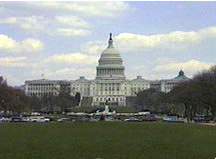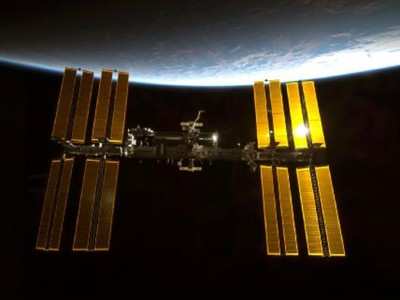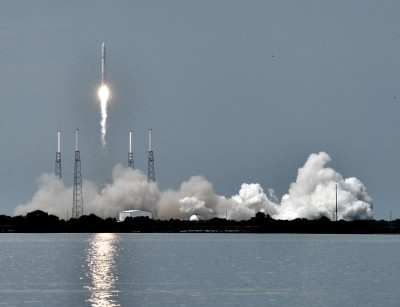Legislation Supports Domestic Commercial Crew Initiatives
 SpaceX (Space Exploration
Technologies) said in a news release Tuesday that it applauds the
efforts of the Senate Commerce, Science and Transportation
Committee for their unanimous, bipartisan approval of the NASA
Authorization Act of 2010. SpaceX says this landmark legislation
ushers in a new era in human spaceflight by embracing the
commercial sector as a full partner and recognizing commercial crew
services as the primary means of astronaut transport to the
International Space Station (ISS).
SpaceX (Space Exploration
Technologies) said in a news release Tuesday that it applauds the
efforts of the Senate Commerce, Science and Transportation
Committee for their unanimous, bipartisan approval of the NASA
Authorization Act of 2010. SpaceX says this landmark legislation
ushers in a new era in human spaceflight by embracing the
commercial sector as a full partner and recognizing commercial crew
services as the primary means of astronaut transport to the
International Space Station (ISS).
“We are pleased that the Senate Commerce Committee has
recognized that the best and only near-term option for eliminating
America’s reliance on the Russian Soyuz for astronaut
transportation is the development and use of commercial systems,
such as SpaceX’s Falcon 9 and Dragon spacecraft,” said
Elon Musk, CEO & CTO, SpaceX. “For about the same amount
that is currently being spent on purchasing seats on Russian launch
vehicles, we can create thousands of high-tech, high-paying jobs
right here at home.”
 In 2010, NASA will pay the Russian
Space Agency $287.4 million for 6 seats on Russian Soyuz flights,
which amounts to $47.9 million per seat. By 2013, the price per
seat paid to Russia to carry U.S. astronauts will exceed $55
million.
In 2010, NASA will pay the Russian
Space Agency $287.4 million for 6 seats on Russian Soyuz flights,
which amounts to $47.9 million per seat. By 2013, the price per
seat paid to Russia to carry U.S. astronauts will exceed $55
million.
The bill would direct NASA to continue the Commercial Orbital
Transportation Services Program (COTS) in support of providing
cargo services to the ISS and would establish a requirement for the
definition of milestones and minimum performance objectives to be
achieved before procurement authority is granted for crew
development capability.
It would also authorize and direct NASA to fly the space shuttle
Launch on Need (LON) flight pending results of a required
assessment of safe means of return for astronauts if the shuttle is
damaged or unable to return. The bill also would preserve
space shuttle capabilities through 2011 to complete the current
manifest. It would also prohibit termination of any contracts that
would inhibit launching of the space shuttle. And, it would extend
full utilization of the ISS through at least 2020 and ensure safe
and effective operation, maintenance and maximum utilization of ISS
through a comprehensive report to Congress of essential systems,
components, elements, etc., on board or planned for delivery and
installation, including replacement parts needed through 2020.

The bill would direct NASA to initiate development of a
government-owned, NASA-designed and operated “ Space Launch
System” (SLS) – a heavy lift launch capability - as
soon as practicable and would establish the end of 2016 as the goal
for full operational capability while allowing for modification
and/or extension of existing contracts. The bill would
require NASA to develop a multi-purpose crew transportation vehicle
based on Orion for use with the Space Launch System.
Though it provides less funding than the President’s
request, the new legislation provides $312 million in FY11 funding
for the development of American commercial systems to transport
crew to the ISS. SpaceX is one of several companies currently
developing commercial crew technology funded by NASA, including
Nevada-based Sierra Nevada Corporation, Illinois-based Boeing
Company, Colorado-based United Launch Alliance, Washington-based
Blue Origin, Nevada-based Bigelow Aerospace, and Arizona-based
Paragon Space Development Corporation.

SpaceX Falcon 9 Launch
SpaceX successfully launched its Falcon 9 rocket carrying a
Dragon spacecraft test article in June 2010, meeting 100% of
mission objectives on its first attempt. The first demonstration
flight with a fully operational Dragon spacecraft is targeted for
late summer 2010. This flight will be the first under NASA’s
Commercial Orbital Transportation Services (COTS) program which was
established in 2006 to encourage private companies to develop
commercial space transport capabilities. SpaceX currently employs
over 1,100 people across California, Texas and Florida.
 ANN's Daily Aero-Linx (05.06.25)
ANN's Daily Aero-Linx (05.06.25) ANN's Daily Aero-Term (05.06.25): Ultrahigh Frequency (UHF)
ANN's Daily Aero-Term (05.06.25): Ultrahigh Frequency (UHF) ANN FAQ: Q&A 101
ANN FAQ: Q&A 101 Classic Aero-TV: Virtual Reality Painting--PPG Leverages Technology for Training
Classic Aero-TV: Virtual Reality Painting--PPG Leverages Technology for Training Airborne 05.02.25: Joby Crewed Milestone, Diamond Club, Canadian Pilot Insurance
Airborne 05.02.25: Joby Crewed Milestone, Diamond Club, Canadian Pilot Insurance






